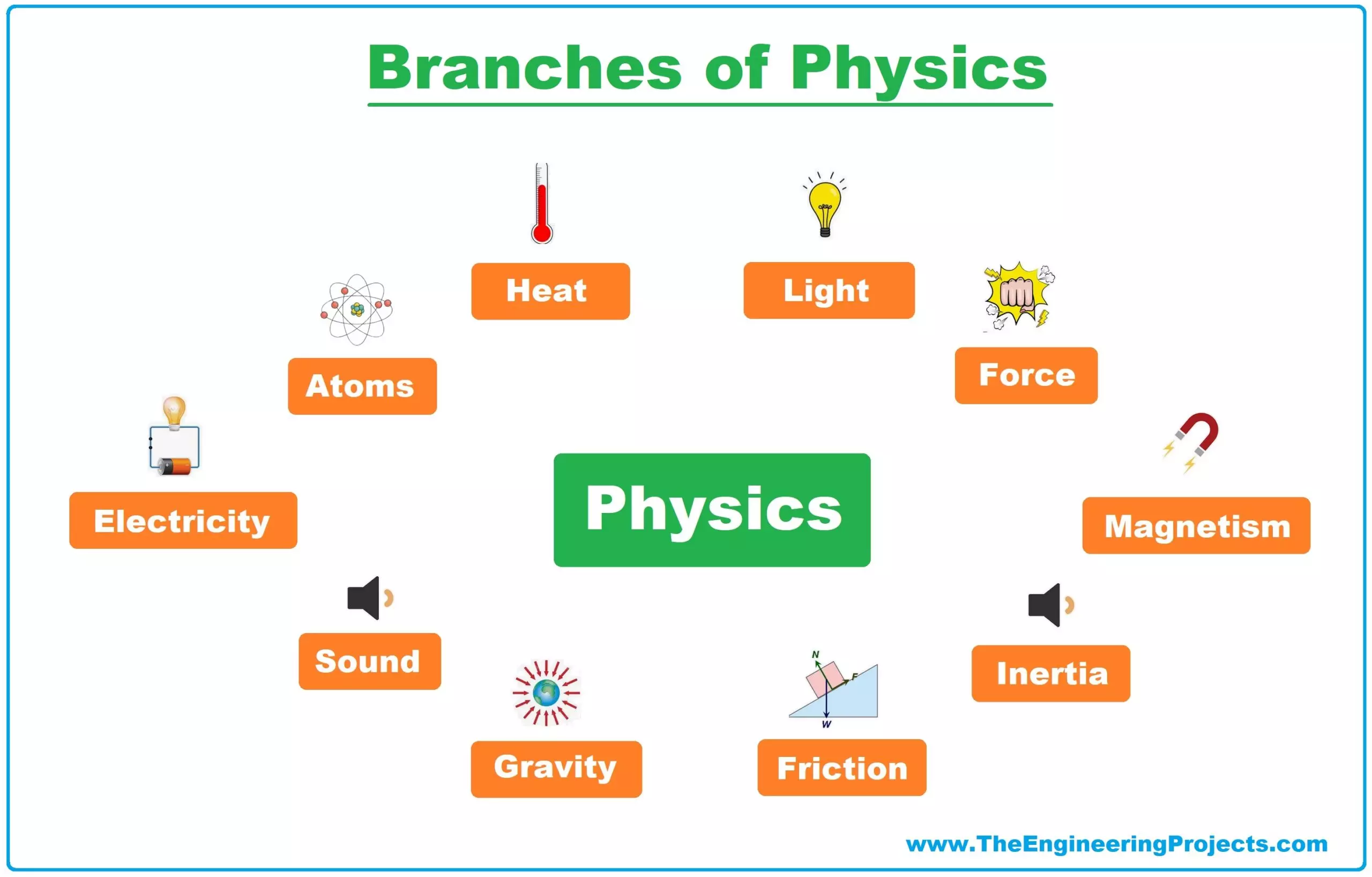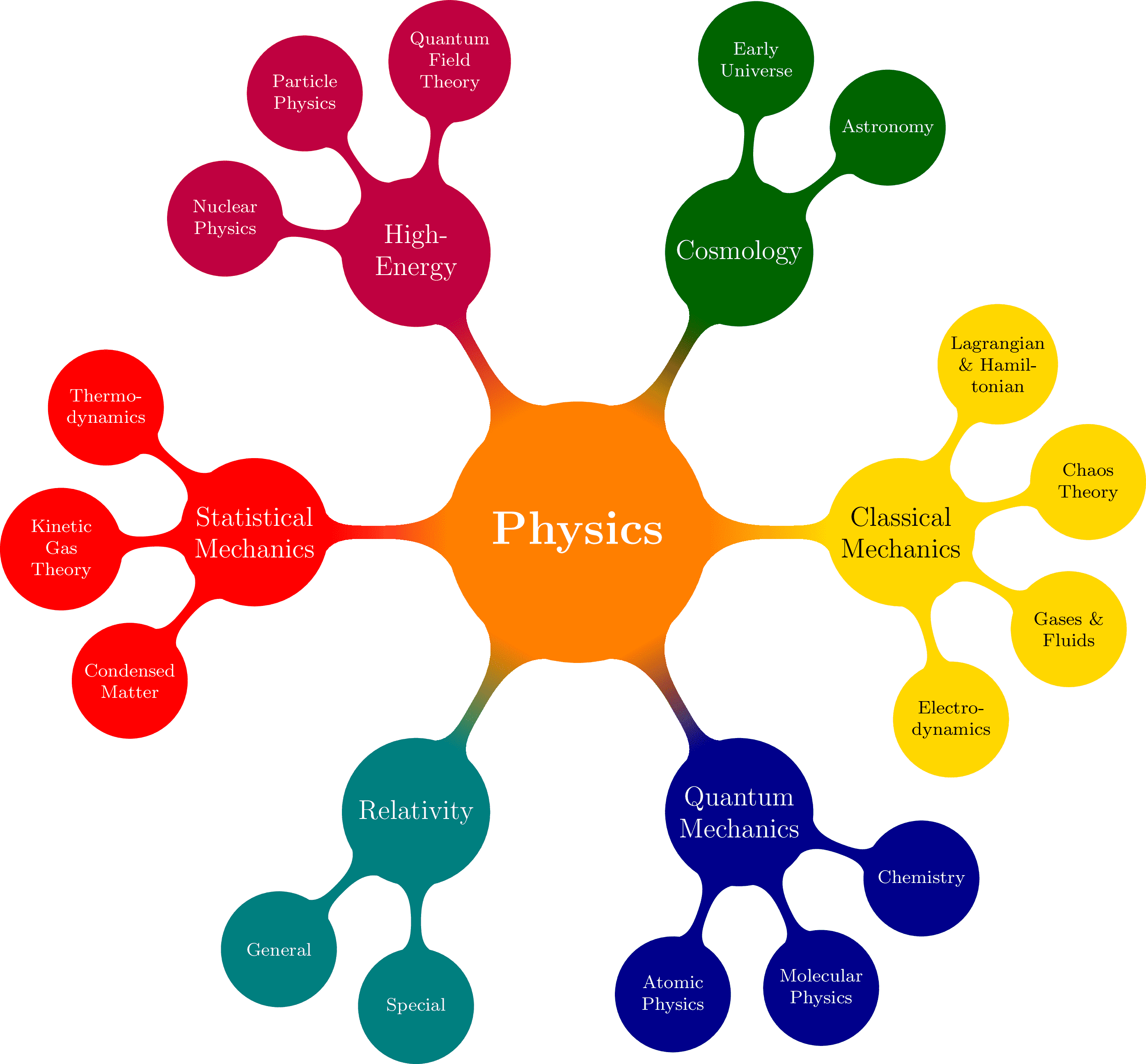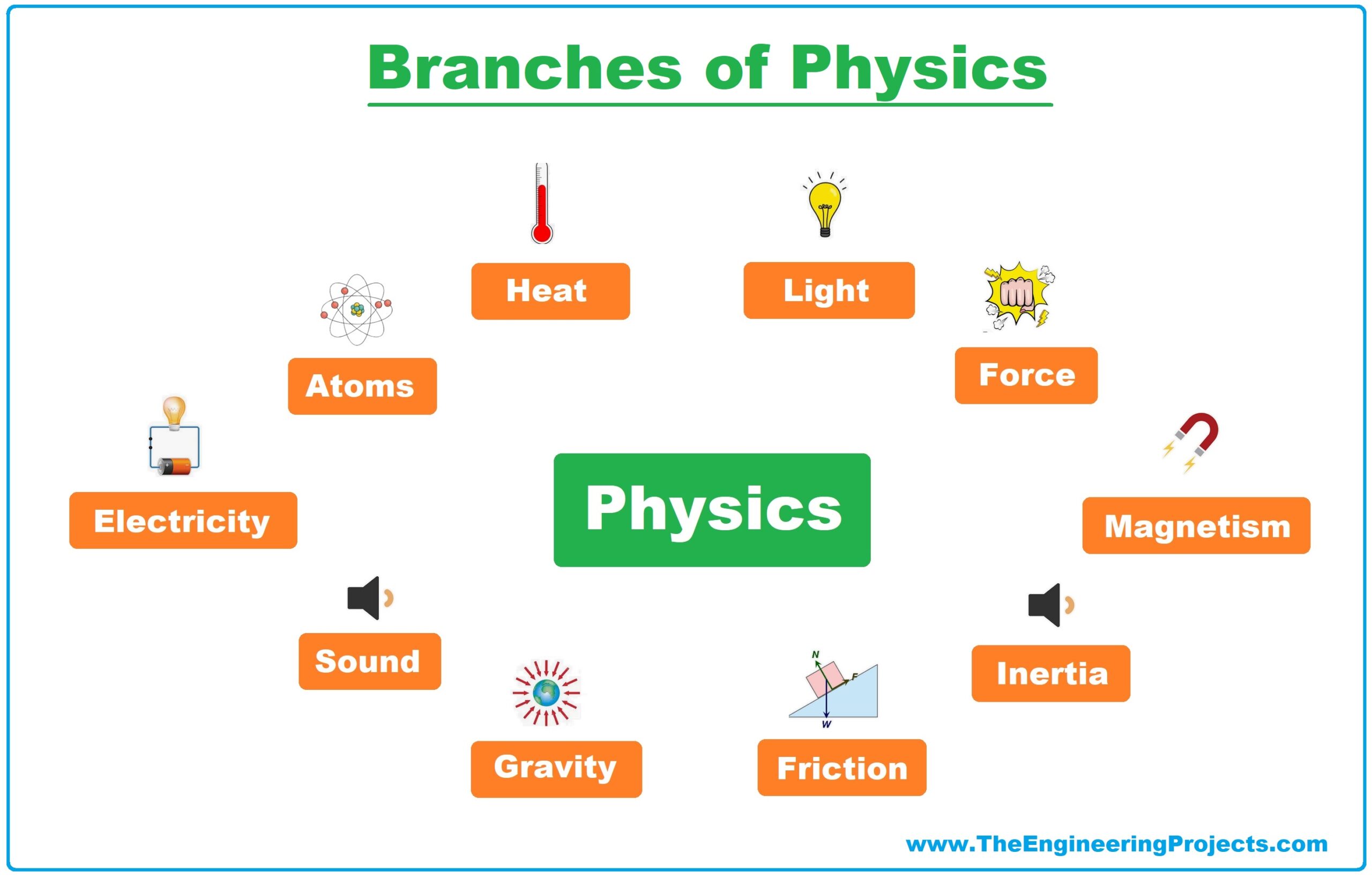Branches of Physics: Unveiling the Mysteries of the Universe
- Update Time : Tuesday, December 31, 2024

Branches of Physics: Physics is a vast field that touches every aspect of the universe. It seeks to understand the very fabric of reality.
Dive into the branches of physics, where each segment offers a unique lens to examine the cosmos. From the particles that form the building blocks of matter to the complex interactions of energy and forces, physics is the bedrock of scientific discovery.
It has shaped our understanding of the world, propelling technological advancements and deepening our grasp of the universe’s mysteries. Exploring the different branches, we find distinct paths of study, each with its focus and methods. Classical mechanics deals with the motion of objects, while quantum mechanics delves into the peculiar behaviors of subatomic particles. Electromagnetism explores the relationship between electricity and magnetism, and thermodynamics examines heat and energy transfer. These are just the starting points. As we journey through each branch, we uncover the principles that govern our world, from the grand scale of galaxies to the minutiae of quarks. Join us as we unravel the threads of knowledge that weave together to form the fascinating tapestry of physics.
Introduction To Physics
Physics is the natural science that studies matter, energy, and the fundamental forces of the universe. It provides us with the framework for understanding the very fabric of reality. With its laws and theories, physics helps us make sense of the world around us, from the smallest particles to the vast cosmos.
The Role Of Physics In Understanding Reality
Physics serves as the backbone of all sciences. It explains how things work. From gravity that holds us to the Earth to the energy fueling the stars, physics uncovers the rules that govern our existence. The study of matter and energy reveals the universe’s secrets, guiding technological advances and enhancing our quality of life.
How Physics Branches Out To Explore The Cosmos
Physics expands into various branches to uncover the universe’s mysteries. Astrophysics studies celestial bodies, while quantum physics delves into the peculiar world of subatomic particles. Each branch, from thermodynamics to electromagnetism, plays a crucial role in exploring space and time, driving us closer to answering the ultimate questions about our cosmos.
Classical Mechanics
Classical Mechanics forms the foundation of Physics. It explains how things move. This branch studies objects in motion and forces acting on them. It’s about the laws that govern our daily lives. Simple, yet profound.
Laws Of Motion And Gravity
Imagine throwing a ball or driving a car. These actions follow specific rules. These rules are known as the laws of motion. Isaac Newton introduced them. They tell us how objects move on Earth and in space.
Gravity pulls us down. It keeps our feet on the ground. Newton also explored gravity. He showed how it makes apples fall and keeps planets in orbit.
The Impact Of Newtonian Physics
Newtonian physics shapes our world. It helps engineers build bridges and cars. It aids in predicting how objects will move. Thanks to Newton, we sent astronauts to the moon. We launched satellites. His ideas opened doors to new inventions. They guide us in understanding the physical world.
Electromagnetism
Imagine a force that shapes everything from the smallest atom to the largest galaxy. This force, known as electromagnetism, is one of the four fundamental forces in the universe. It explains how particles interact with each other through electric and magnetic fields. These interactions are vital in daily life, powering everything from smartphones to medical equipment. Let’s dive into the electric world of electromagnetism and see how it powers our modern lives.
From Maxwell To Modern Electronics
James Clerk Maxwell was a pioneer in the field of electromagnetism. His equations laid the groundwork for much of today’s technology. Maxwell’s discoveries showed us that electric and magnetic fields travel through space as waves. These waves form the basis of countless innovations in the field of electronics. Thanks to him, we have radios, televisions, and computers. His work was a stepping stone that led to the digital age.
The Force That Lights Up Our World
Electromagnetism does more than just power devices. It’s the reason we can see. Light is an electromagnetic wave that our eyes can detect. This force illuminates homes, streets, and cities. It keeps us warm, cooks our food, and entertains us. Without electromagnetism, the world would be a dark and silent place. It’s a force that truly lights up our world, touching every aspect of our lives.

Credit: www.theengineeringprojects.com
Thermodynamics
Imagine a world where we can predict how heat moves, how engines work, or how cold your ice cream stays on a hot day. This is the realm of thermodynamics, a branch of physics that deals with heat and temperature and their relation to energy and work. It shapes the way we understand the behavior of the physical world, from the smallest particles to the vastness of the cosmos.
The Essence Of Heat And Energy Transfer
Thermodynamics is all about movement. Heat moves, energy flows. This branch of physics tells us how and why. It’s a dance of molecules, a shuffle of atoms, all moving from hot to cold. It’s the reason your coffee cools down and why the sun warms the earth.
Applications From Engines To The Universe’s Fate
Engines roar to life thanks to thermodynamics. It’s the science that explains how fuel turns into motion. But it’s not just about machines; it’s about stars, planets, and the whole universe. The fate of all things, from the tiniest particles to the vast reaches of space, follows the laws of thermodynamics. This science touches everything.
Quantum Mechanics
Quantum Mechanics stands as a vital branch of Physics. It dives into the tiny world of atoms and particles. This realm is far from the everyday large-scale experiences. Here, normal rules don’t apply. Instead, strange and fascinating behaviors emerge. Let’s explore some key aspects of Quantum Mechanics.
The Peculiar Behavior Of The Microscopic World
In the world of Quantum Mechanics, particles can exist in many places at once. They act like waves and particles at the same time. This duality puzzles scientists. A famous experiment, the double-slit experiment, shows this. Light behaves like both a particle and a wave. This finding challenges our understanding of the physical world.
Quantum Theory And Technological Revolutions
Quantum theory has led to big changes in technology. It’s behind lasers, computers, and MRI machines. These devices shape our modern life. Without quantum theory, none of this tech would exist. The theory also hints at future tech. Quantum computers are one example. They promise to solve problems beyond current computers’ reach.

Credit: tikz.janosh.dev
Relativity
Delving into the depths of physics, ‘Relativity’ emerges as a cornerstone concept. This powerful theory reshapes our understanding of space, time, and gravity. Albert Einstein’s groundbreaking work laid the foundation for modern physics, altering the way we perceive our universe.
Einstein’s Vision Of Space-time
Albert Einstein changed history with his theory of relativity. He proposed that space and time are interwoven, a concept known as space-time. This idea was revolutionary. It suggested that time could speed up or slow down, depending on the speed of an object.
- Mass warps space-time.
- Time dilation occurs at high speeds.
- Gravity is the curvature of space-time.
These concepts challenge traditional views. They reveal a universe more intricate and connected than ever imagined.
Implications For Cosmology And GPS Technology
Relativity extends beyond theoretical physics. It has practical implications in cosmology and technology. Einstein’s theories help us understand cosmic phenomena and keep GPS systems accurate.
| Cosmology | GPS Technology |
|---|---|
| Expanding Universe | Satellite Time Correction |
| Black Holes | Precise Location Data |
| Big Bang Aftermath | Navigation Reliability |
Relativity ensures GPS satellites account for time dilation. This makes navigation systems reliable. In cosmology, it explains the behavior of stars, galaxies, and the universe’s expansion.
Particle Physics
Delving into the world of Particle Physics, we uncover the fundamental constituents of the universe. This branch explores the smallest building blocks of matter, seeking to understand how they interact and combine to form everything around us.
The Building Blocks Of Matter
Particle Physics peels back layers of matter to reveal the core. Atoms, once considered the smallest units, are made of smaller parts: protons, neutrons, and electrons. But there’s more. Even these particles are not the end of the story. Quarks and leptons emerge as true fundamental particles, with forces like gravity, electromagnetism, and nuclear interactions holding them together.
- Atoms: The basic units of chemical elements
- Protons and Neutrons: The nucleus builders
- Electrons: Orbiting the nucleus
- Quarks: The constituents of protons and neutrons
- Leptons: Including the familiar electron
Discoveries From Atom Smashers
Large Hadron Collider (LHC) and other accelerators collide particles at high speeds. These “atom smashers” recreate conditions from the early universe. They help scientists discover new particles like the Higgs boson.
New particles often exist for just a fraction of a second. Yet, they can tell us a lot about the forces that shape our world. Experiments at the LHC and similar facilities look for answers to big questions. They explore dark matter, antimatter, and the origins of mass.
| Year | Discovery |
|---|---|
| 2012 | Higgs boson |
| 1964 | Quarks |
Astrophysics And Cosmology
Exploring the vastness of space excites many. Astrophysics and Cosmology take us on this journey. They help us understand stars, galaxies, and much more. These branches of physics make the universe less mysterious.
Stars, Galaxies, And The Universe’s Evolution
Stars light up our night sky. They are like the universe’s dots. Galaxies are big families of stars. They come in different shapes and sizes. Understanding them helps us know how the universe grows and changes.
- Stars are born, live, and die. Their life cycle is fascinating.
- Galaxies can have billions of stars. They form big groups in space.
- The universe is getting bigger. Scientists study this to learn about its future.
Unraveling The Secrets Of Dark Matter And Dark Energy
Not everything in space shines. Some things are invisible. We call these dark matter and dark energy. They are mysteries of space. Scientists work hard to understand them.
Dark matter pulls things together. It helps galaxies stay in shape. Dark energy does the opposite. It makes the universe expand faster. Together, they make up most of the universe. Yet, we know little about them.
- Dark matter cannot be seen. But it has a big effect on galaxies.
- Dark energy drives the universe’s expansion. It is a big puzzle.
- Understanding them could change how we see the universe.
Condensed Matter Physics
Condensed Matter Physics explores the microscopic and macroscopic properties of solid and liquid matter. This branch of physics dives deep into understanding how materials behave and interact at both atomic and molecular levels. It’s a field that stretches the boundaries of our knowledge about the physical world. From the hardness of diamonds to the fluidity of water, Condensed Matter Physics seeks to explain these diverse states and properties.
The Study Of Solid And Liquid Matter
Imagine a world where every material’s secrets are unlocked. That’s the goal of studying solid and liquid matter. Scientists in this field work hard to understand why materials act the way they do. They look at atoms and molecules, the building blocks of matter. By doing this, they learn about the strength of metals and the flow of liquids. This knowledge helps in many areas, from building bridges to making medical devices.
Advances In Material Science And Nanotechnology
Science keeps moving forward, and so does our understanding of materials. New tech in nanotechnology changes what we know about tiny particles. It’s all about creating materials that are stronger, lighter, and more efficient. Scientists can now make things at a scale of one billionth of a meter. This progress affects electronics, medicine, and even clean energy. It’s a world of small scales making big impacts.
Plasma Physics
Enter the electrifying realm of Plasma Physics, a branch of physics that studies the complexities and behaviors of plasma. Often referred to as the fourth state of matter, plasma is a hot, charged gas consisting of ions and electrons. This field of physics not only enriches our understanding of the universe but also holds the key to groundbreaking advancements in technology.
Understanding The Fourth State Of Matter
Plasma, unlike solids, liquids, or gases, is made when matter is heated to extreme temperatures or when strong electromagnetic fields are applied. This process ionizes the gas, making it electrically conductive and responsive to magnetic fields. Plasma makes up over 99% of the visible universe, shining brightly in stars and the sun.
Applications From Fusion To Space Propulsion
Plasma Physics paves the way for incredible uses. In energy, fusion reactors aim to mimic the sun, potentially offering near-limitless power. Plasma is also vital in making integrated circuits found in electronics. In space, plasma engines enable spacecraft to travel faster and more efficiently. This science touches daily life and the future of space exploration alike.
- Fusion energy: Clean and abundant power source.
- Electronics manufacturing: Plasma etching shapes our gadgets.
- Medical treatments: Plasma sterilization ensures safety.
- Space technology: Plasma thrusters propel exploration.
Biophysics
Biophysics merges the principles of physics with the complexity of biological systems. It offers a unique lens to examine the structures and processes that make up life. This branch of physics uses physical methods to understand biological phenomena at every level, from molecules to ecosystems.
The Interface Of Biology And Physics
Biophysics stands at the crossroads of biology and physics. It applies theories and methods traditionally used in the physical sciences to questions in biology. By doing so, it helps unlock the secrets of cellular processes and the nature of diseases.
- Explores forces that shape protein folding
- Examines how cells convert energy
- Looks at DNA mechanics
- Studies how organisms sense their environment
Insights Into The Machinery Of Life
At its core, biophysics seeks to explain how and why biological systems work. It dissects the intricate machinery of life, revealing the physical underpinnings of biological functions.
| Focus Area | Biophysical Tools | Biological Insight |
|---|---|---|
| Cell Membrane Dynamics | Electron Microscopy | Transport Mechanisms |
| Enzyme Function | Spectroscopy | Reaction Pathways |
| Neural Signaling | Patch Clamping | Electrical Properties |
Biophysics provides a framework to understand life’s building blocks. It helps us grasp how proteins work and what goes wrong in disease states. With this knowledge, we can develop better drugs and therapies.
Environmental Physics
Environmental Physics explores the interaction between human activity and the planet. It’s a vital part of Physics that studies how energy and materials shape our environment.
Environmental Physics explores how physics applies to Earth’s environment. It looks at energy, matter, and how they shape our world. This field helps us understand climate change and find better energy sources. It’s key for tackling today’s ecological issues. Let’s dive into the ways physics meets ecology and energy.
Physics Applied To Ecological Challenges
Scientists use physics to solve environmental problems. They study air, water, and soil. They look at pollution and how to clean it. Physics gives them tools to measure and fix these issues.
Climate Modeling And Renewable Energy
Experts use physics to predict weather and climate. They create models to see future changes. This work helps to build wind and solar power solutions. Physics guides us to a cleaner, safer planet.
Conclusion: The Unified Nature Of Physics
The study of physics brings a profound understanding of the natural world. It reveals the laws that bind the universe together. This unity in physics shows us that every branch, from quantum mechanics to relativity, is part of a bigger picture.
Interconnectedness Of Physical Laws
Physics thrives on the principles that govern everything. These rules link seemingly unrelated phenomena. For example, the same laws that explain the motion of planets also apply to atoms. This unity underlines the power of physics to explain the world.
The Future Of Physics Research
As we peer into the unknown, physics research stands at the frontier of discovery. It aims to solve mysteries that could change our understanding of the universe. The journey ahead promises exciting new insights as all branches of physics continue to merge into a single, coherent discipline.

Credit: www.theengineeringprojects.com
Frequently Asked Questions
What Are The Main Branches Of Physics?
Physics is divided into classical physics and modern physics. Classical physics covers mechanics, thermodynamics, and electromagnetism, while modern physics includes quantum mechanics and relativity.
How Does Quantum Mechanics Differ From Classical Physics?
Quantum mechanics describes the behavior of particles at the atomic and subatomic levels, where classical physics’ laws do not apply. It introduces the concept of wave-particle duality and uncertainty.
What Is The Role Of Thermodynamics In Physics?
Thermodynamics deals with heat, work, and the energy transfer within systems. It governs the principles of energy conservation and entropy, crucial for understanding heat engines and refrigeration cycles.
Can You Explain Electromagnetism In Simple Terms?
Electromagnetism is the branch of physics that studies electric charges at rest and in motion. It encompasses the laws of electricity, magnetism, and the electromagnetic force between charged particles.
Conclusion
Understanding physics branches helps us grasp the universe’s basics. Think of mechanics, the study of motion. Or consider thermodynamics, which explains heat and energy. Each branch, from electromagnetism to quantum physics, offers insights into our world. Exploring these fields can spark interest in young scientists.
Remember, physics touches every part of life. It makes our modern world work. Keep curious, keep learning, and the wonders of physics will keep amazing you. Ready to explore more? The journey into science awaits.


















Leave a Reply